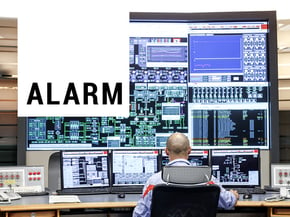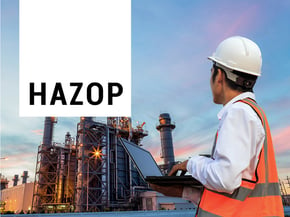Process Safety Blog
Process Safety Consequences
Consequence modelling is used to determine the worst-case scenarios that could occur due to a loss of containment of hazardous materials. This is helpful for several reasons, e.g., helping to better understand risks (risk is a combination of the severity of an incident with the probability of occurrence). Knowing the risk of incidents means that they can be compared to a tolerable risk criterion to decide if the safeguards in place are adequate or not and to demonstrate whether the risk has been reduced So Far As Is Reasonably Practicable (SFAIRP) or As Low As Reasonably Practicable (ALARP) in regimes where this is a legal requirement. Another reason for knowing the worst-case scenarios is to help in the development of an emergency response plan, e.g., you may want to ensure that emergency muster points are located outside high-risk zones and that escape routes are not impeded. Many scenarios can occur when a hazardous substance is released into the environment, these are primarily fires, explosions, and toxic releases. There are many different types of fires and explosions that can occur, and the nature of the consequence is dependent on the properties of the substance released, the process conditions (temperature, pressure) of that substance, weather conditions, the release location and whether ignition is immediate or delayed.
Fires
Several different types of fire can occur, these are primarily pool fires, jet fires and flash fires.
Pool Fires - These occur when a flammable liquid from a vessel or pipeline forms a pool on the ground, if ignition occurs this causes a pool fire. The height of the flame is typically twice the diameter of the pool and size is limited by heat from the flame onto the pool affecting the vaporisation rate.
The following video demonstrates a pool fire.
Jet Fires - Occur when a flammable liquid, vapour or two-phase material that is under pressure leaks from a vessel or pipeline and finds a source of ignition. A leak of approximately 2 Barg or greater is required, at such pressures choked flow occurs which means the flow will reach sonic velocities. If ignition occurs this produces a flame with significant momentum and the result is a jet fire. Unlike other types of fire, jet fires are directional. The size of the jet fire is impacted by the pressure in the vessel or pipeline and the hole size.
The following video demonstrates a jet fire.
Both pool fires and jet fires emit thermal radiation which can cause serious harm or fatalities to people who are exposed to this radiation. The intensity of the heat that a person is exposed to is dependent on the thermal radiation emitted from the fire and the distance the person is from the fire.
Pool fires and jet fires may also impinge on vessels and equipment containing hazardous substances leading to mechanical failure and potentially a secondary consequence such as a Boiling Liquid Expanding Vapour Explosion (BLEVE) which will be discussed later.

|

|

|
| Find out about our upcoming Hazardous Area Classification Training Course HERE! | We offer Consulting Services for Hazard Identification HERE! | Find out about our upcoming HAZOP LEADER Training Course HERE! |
Flash Fires - When a flammable vapour is released and ignition is not immediate, it will form a cloud that may be within its flammable range. If the cloud is not in a congested area and delayed ignition occurs the result is a flash fire.
The resulting flame front is laminar (smooth flow with little or no mixing) and travels below sonic velocity (consequently no detonation or pressure waves are formed). Significant thermal radiation is generally considered to be only inside the bounds of the cloud and there is no damage from overpressure or projectiles. Flash fires are affected by release rate and weather conditions, with calm stable conditions more likely to result in a flash fire. If a person is caught inside the flash fire envelope when ignition occurs, it is likely to be fatal.
The following video link demonstrates a flash fire that occurred due to a large release of gasoline at a storage facility, pay attention to the flash fire at 3:14 in the video.
Explosions - There are several different types of explosions that can occur, these are primarily Vapour Cloud Explosions (VCEs) and BLEVEs which will be discussed in more detail. There are other types of explosions such as dust explosions that can also occur that can be equally destructive but won’t be discussed in this blog.
VCEs - Like flash fires, VCEs are the result of delayed ignition of a flammable vapour cloud that’s within its flammable range. If when ignition occurs, part of the flammable vapour cloud is congested by buildings or plant equipment, the result is a VCE. If there is no congestion, a VCE would not occur, and the result would be a flash fire.
Due to the congestion, the resulting flame front is turbulent and reaches detonation velocity, causing a significant rise in pressure. The overpressure waves can cause significant damage to people, equipment, and buildings. The magnitude of the overpressure wave that a person is exposed to depends on the volume/mass of flammable material contained within the congested space, the strength of the initial explosion and the distance the person is from the explosion. VCEs are also affected by weather conditions with calm stable conditions more likely to result in a VCE.
The following article link is a great example of a VCE that occurred after a gas leak at a house in Christchurch, New Zealand. The effect of the overpressure is obvious as the house was destroyed.
www.nzherald.co.nz/nz/christchurch-gas-explosion-negligent-tradesman-stung
BLEVEs - When a pressurised vessel containing a liquid above its boiling point at atmospheric pressure fails, the result is a BLEVE. The vessel failure can be due to impact, corrosion, or external heating such as flame impingement. A BLEVE can occur with any liquid whether flammable or not, even water can cause a BLEVE. When the vessel fails the liquid immediately flashes sending out a shock wave, which like a VCE can cause damage to people, equipment, and buildings. If the liquid/vapour is also flammable there will also be a fireball which will send out an intense dose of thermal radiation over a short period. This thermal dose can also cause serious injuries or fatalities. The size of a BLEVE is determined by the volume of material released and the burst pressure.
The following video link demonstrates a BLEVE due to flame impingement with the resulting overpressure waves and fireball clearly visible.
Toxic Releases - When a toxic substance is released into the environment, it will mix with the air and disperse. Toxic substances have the potential to cause serious harm or fatalities to people. The rate of mixing and dispersion is dependent on weather conditions (wind speed and direction, stability, humidity, and air temperature), the amount of material released, the location/direction, temperature and density of the material released.
The following video link demonstrates a toxic release of chlorine that occurred at a port in Jordan, that occurred when a container containing chlorine gas was dropped and then ruptured, causing 12 fatalities.
In conclusion
Consequence modelling is a useful tool to help determine the worst-case scenarios in a plant or facility. There are several different consequence modelling programs available in the market. However, there is a risk of not understanding the data being entered into the software and even using software, the results are meaningless unless the data is inputted, and the results interpreted correctly. It’s recommended that this is done by someone with adequate skills and experience.
As an added piece of guidance, we have developed a checklist that we use when auditing consequence modelling work we have carried out for facilities. This checklist helps to ensure any dispersion modelling for a facility has adequately considered the range of conditions that may be present during a major incident.
Ready to take your process safety strategy to the next level?
Explore our PROCESS SAFETY TRAINING COURSES HERE, to build practical, defensible safety solutions. Visualise potential incident outcomes to strengthen decision-making. Contact us about Consequence Modelling Services.
Have questions or need guidance? GET IN TOUCH. We're here to help.

